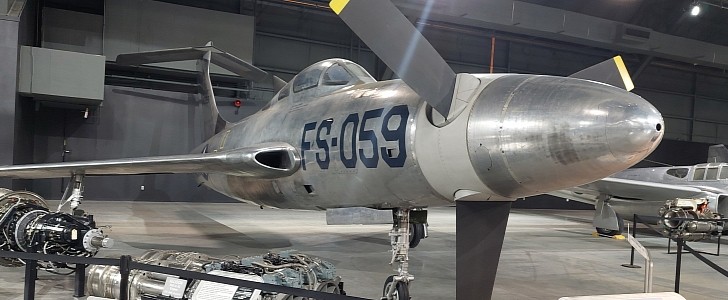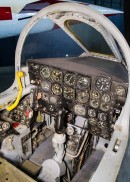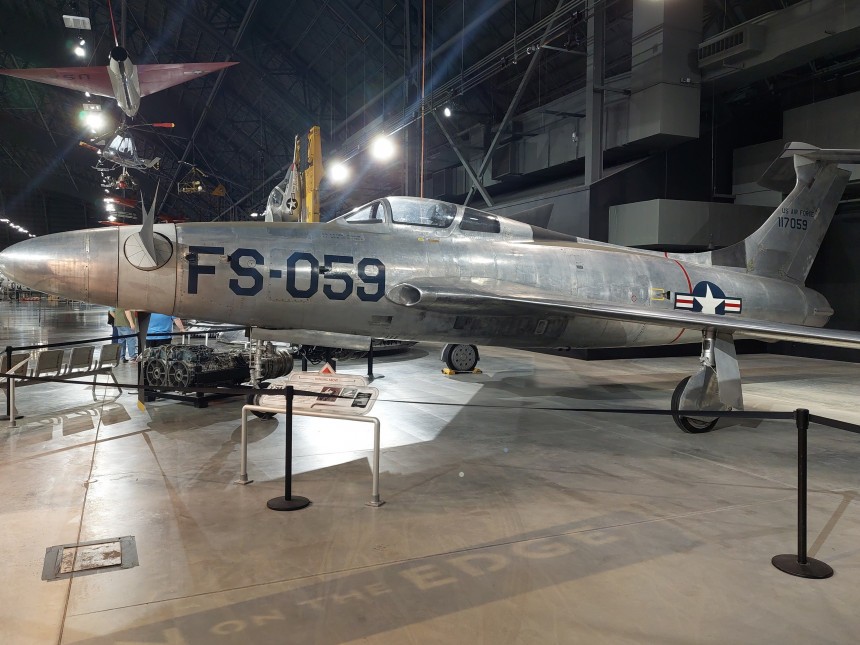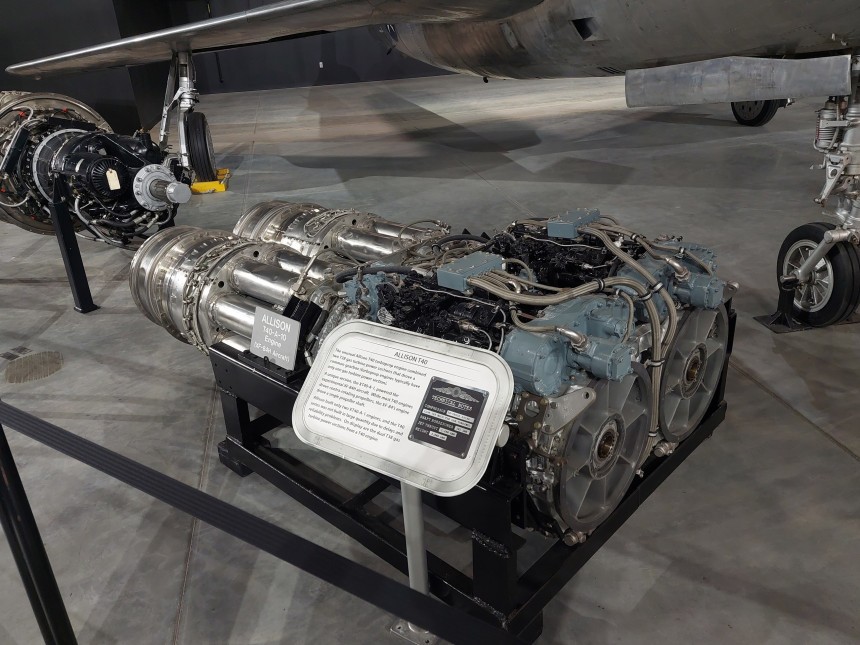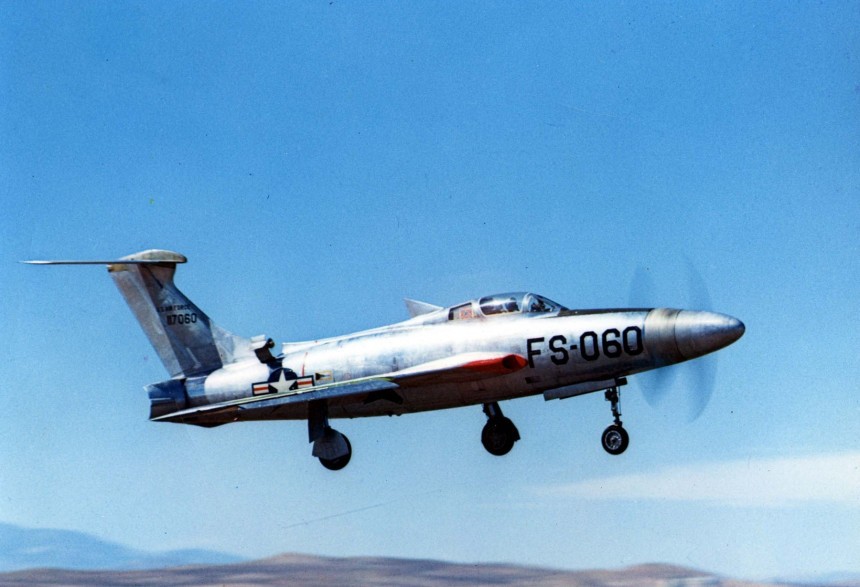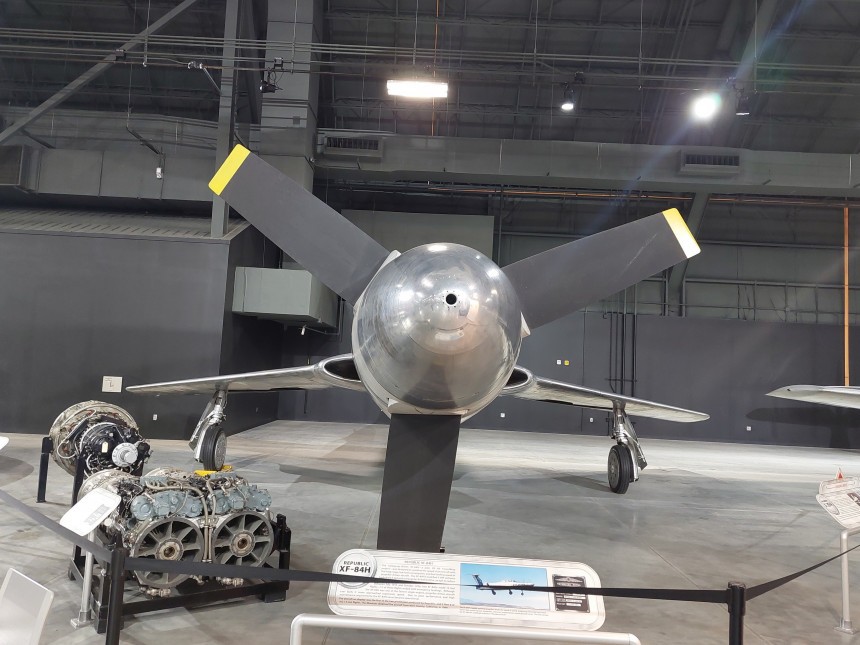Some amazing airplanes rolled off the factory floor at Republic Aviation's factory in Farmingdale, New York. Lots of their designs are well known and well celebrated. Like The mighty P-47 Thunderbolt, the rugged F-84 Thunderjet, or the awe-inspiring A-10 Warthog.
Even so, Republic and then Fairchild-Republic after it had a bit of a one-trick pony reputation all those years ago. With only one of its designs, every reaching American icon status at any given time. To put it mildly, some of these designs were epic fails before "epic fail" was the cornerstone of online gaming lexicons. The truth is, Republic had all sorts of wacky ideas in its time as Long Island, New York's second big aerospace company. Behind the famed Grumman Aerospace.
Want living proof? Look no further than the RF-84H Thunderscreech, a plane designed by Republic, commissioned by the Navy, "gifted" to the Air Force, and written off as useless by all three. Why? Because it harmed multitudes more of its own pilots and ground crew than it ever did enemy fighters.
The immediate aftermath of World War Two was bizarre for a long list of different reasons. Military aviation wasn't exempt from this phenomenon. If anything, things were more freaky here than many other places and things at the time. But one thing was abundantly clear come to the end of the global conflict.
The final cease-fire of the Japanese in the summer of 1945 essentially ended the dominance of the piston-engined fighter plane. From then on, and even today, turbine jet engines were christened the way of the future. But there were more than a few teething problems to attend to, especially in the beginning.
Even so, Republic and then Fairchild-Republic after it had a bit of a one-trick pony reputation all those years ago. With only one of its designs, every reaching American icon status at any given time. To put it mildly, some of these designs were epic fails before "epic fail" was the cornerstone of online gaming lexicons. The truth is, Republic had all sorts of wacky ideas in its time as Long Island, New York's second big Aerospace company. Behind the famed Grumman Aerospace.
Want living proof? Look no further than the RF-84H Thunderscreech, a plane designed by Republic, commissioned by the Navy, "gifted" to the Air Force, and written off as useless by all three. Why? Because it harmed multitudes more of its own pilots and ground crew than it ever did enemy fighters.
The immediate aftermath of World War Two was bizarre for a long list of different reasons. Military aviation wasn't exempt from this phenomenon. If anything, things were more freaky here than many other places and things at the time. But one thing was abundantly clear by the end of the global conflict.
The final cease-fire of the Japanese in the summer of 1945 essentially ended the dominance of the petroleum-powered, piston-engined fighter plane. From then on, and even today, turbine jet engines were chosen as the way of the future. But there were more than a few teething problems to attend to, especially in the beginning.
The added lift from the propellers was thought to allow the jet to take off from existing U.S. Navy carriers left over from World War Two and Korea. Alone, the T-38 made a measly 2,250 horsepower at the prop shaft. For comparison, a mildly tuned Prat & Whittney R-2800 radial or Rolls-Royce Griffon V12 could match those figures for considerably less money. In real world conditions, at least, the piston engine was the superior, at least in a single engined Navy fighter platform. So perhaps the twin-engine idea wasn't so ludacrous after all, at least in the early 1950s.
The Republic team was no doubt keen to keep up with the break-neck development taking place just a few miles west down New York route 109 at Grumman Aviation in Bethpage. By this point, the venerable Grumman F9F Panther had earned its keep over the skies of Korea. So too did Republic throw its fighter into the fray in their F-84 Thunderjet. A straight-winged, sub-sonic jet with a deadly arsenal of bombs, rockets, and 50. caliber M3 Browning Machine Guns.
It was from this design that Republic forged the Thunderscreech. Shared components include the main fuselage, canopy, and landing gears, and the wings and control surfaces came from the Thunderjet's upgraded sibling, the swept-winged F-84 Thunderstreak. The airframe was reinforced to withstand a jet that could break the sound barrier in a screaming power-dive, with emphasis on screaming.
And here, we find the Thunderscreech's Achille's heel. Its supersonic propellers spun so ferociously that their tips created mini sonic booms as they smashed mach-one. The innermost portion of a propeller will always turn slightly slower than its outermost tip, and not by an insignificant amount either.
This phenomenon creates a frisbee-like effect that, hurled mini sonic booms at airport ground crews as they worked on and around the plane. Yaknow, like a Mortal Combat character, or something. As awesome as that sounds to a nine-year-old, this effect caused havoc wherever the plane flew. Grounds crew, pilots, and even engineers in the hangars were made physically nauseous by the constant assault of supersonic propellers.
We're not joking! When the human body is exposed to such extreme and constant hellacious noise, your central nervous system essentially goes "nope" and goes haywire. The sectors of the brain that determine natural body responses to outside stimuli can only deduce that you've been poisoned by whatever was making that infernal thumping noise. One Air Force personnel member even collapsed unconscious and suffered a seizure on one test flight.
The problem was so bad that the Navy backed out of the program and left the Air Force to finish the plane's testing. The Air Force promptly threw the blueprint in the trash and never bothered to borrow the proverbial keys from Republic test pilots. Pilots noted that the added lift from the dual-propellers added little thrust in real-life conditions, at least in its final configuration. The clunky engine's vibrations shook them half to death as an added cherry on a mediocre sundae made of aluminum and unsatisfied expectations.
At least the Thunderscreech held the unofficial record for airspeed in a prop-driven fighter at 520 mph (840 km/h) (Mach 0.70) until 1989, so good for it, we guess? And so Republic, the Navy, and finally the Air Force gave up on the design in favor of more practical jet designs. Only a single Thunderscreech, serial number 51-17059, survives.
Pristinely preserved and on display at the National Museum of the United States Air Force in Dayton, Ohio. As ludicrous as this jet is on paper, there's something strikingly wonderful and strikingly beautiful about Republic's absurd design in the flesh and up close. A bit like an old V12 Lamborghini. Beautiful to look at and shockingly loud, but you'd never want to own one; at least there's always the A-10. Check back for more bonkers military tech from museums across America here on autoevolution.
Want living proof? Look no further than the RF-84H Thunderscreech, a plane designed by Republic, commissioned by the Navy, "gifted" to the Air Force, and written off as useless by all three. Why? Because it harmed multitudes more of its own pilots and ground crew than it ever did enemy fighters.
The immediate aftermath of World War Two was bizarre for a long list of different reasons. Military aviation wasn't exempt from this phenomenon. If anything, things were more freaky here than many other places and things at the time. But one thing was abundantly clear come to the end of the global conflict.
The final cease-fire of the Japanese in the summer of 1945 essentially ended the dominance of the piston-engined fighter plane. From then on, and even today, turbine jet engines were christened the way of the future. But there were more than a few teething problems to attend to, especially in the beginning.
Want living proof? Look no further than the RF-84H Thunderscreech, a plane designed by Republic, commissioned by the Navy, "gifted" to the Air Force, and written off as useless by all three. Why? Because it harmed multitudes more of its own pilots and ground crew than it ever did enemy fighters.
The immediate aftermath of World War Two was bizarre for a long list of different reasons. Military aviation wasn't exempt from this phenomenon. If anything, things were more freaky here than many other places and things at the time. But one thing was abundantly clear by the end of the global conflict.
The final cease-fire of the Japanese in the summer of 1945 essentially ended the dominance of the petroleum-powered, piston-engined fighter plane. From then on, and even today, turbine jet engines were chosen as the way of the future. But there were more than a few teething problems to attend to, especially in the beginning.
The Republic team was no doubt keen to keep up with the break-neck development taking place just a few miles west down New York route 109 at Grumman Aviation in Bethpage. By this point, the venerable Grumman F9F Panther had earned its keep over the skies of Korea. So too did Republic throw its fighter into the fray in their F-84 Thunderjet. A straight-winged, sub-sonic jet with a deadly arsenal of bombs, rockets, and 50. caliber M3 Browning Machine Guns.
It was from this design that Republic forged the Thunderscreech. Shared components include the main fuselage, canopy, and landing gears, and the wings and control surfaces came from the Thunderjet's upgraded sibling, the swept-winged F-84 Thunderstreak. The airframe was reinforced to withstand a jet that could break the sound barrier in a screaming power-dive, with emphasis on screaming.
And here, we find the Thunderscreech's Achille's heel. Its supersonic propellers spun so ferociously that their tips created mini sonic booms as they smashed mach-one. The innermost portion of a propeller will always turn slightly slower than its outermost tip, and not by an insignificant amount either.
We're not joking! When the human body is exposed to such extreme and constant hellacious noise, your central nervous system essentially goes "nope" and goes haywire. The sectors of the brain that determine natural body responses to outside stimuli can only deduce that you've been poisoned by whatever was making that infernal thumping noise. One Air Force personnel member even collapsed unconscious and suffered a seizure on one test flight.
The problem was so bad that the Navy backed out of the program and left the Air Force to finish the plane's testing. The Air Force promptly threw the blueprint in the trash and never bothered to borrow the proverbial keys from Republic test pilots. Pilots noted that the added lift from the dual-propellers added little thrust in real-life conditions, at least in its final configuration. The clunky engine's vibrations shook them half to death as an added cherry on a mediocre sundae made of aluminum and unsatisfied expectations.
At least the Thunderscreech held the unofficial record for airspeed in a prop-driven fighter at 520 mph (840 km/h) (Mach 0.70) until 1989, so good for it, we guess? And so Republic, the Navy, and finally the Air Force gave up on the design in favor of more practical jet designs. Only a single Thunderscreech, serial number 51-17059, survives.
